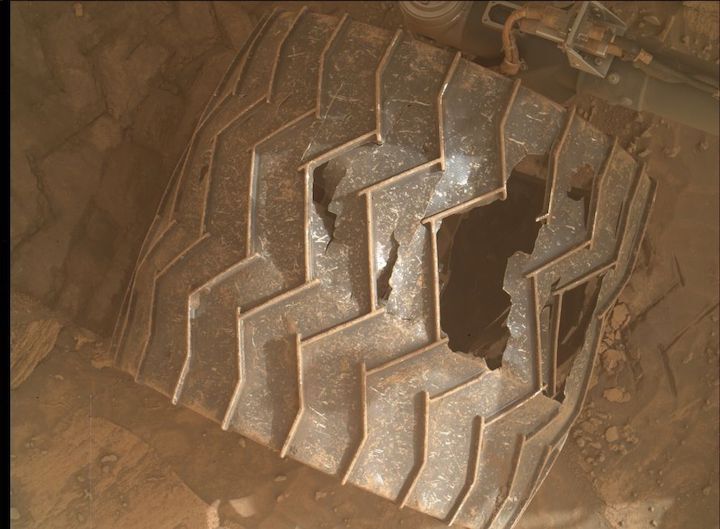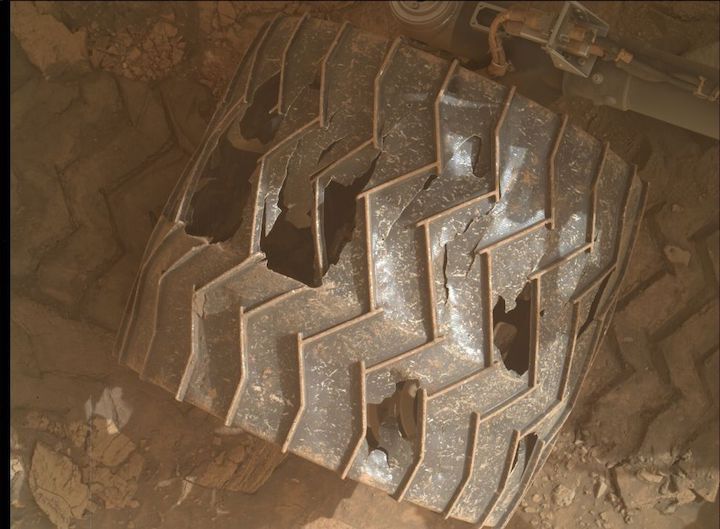10.02.2022
But don't worry; Curiosity should be able to keep roving for a while yet.

The wheels on NASA's Curiosity Mars rover have accumulated some damage during the robot's nine-plus years on the Red Planet, as this photo snapped by Curiosity's Mars Hand Lens Imager (MAHLI) on Jan. 27, 2022, shows. (Image credit: NASA/JPL-Caltech/MSSS)
NASA's Curiosity rover has left plenty of marks on Mars over the past nine-plus years, and the Red Planet is returning the favor.
The rugged landscape inside Mars' Gale Crater has taken some substantial bites out of Curiosity's six aluminum wheels, as CNET recently pointed out. The damage looks dramatic, but don't panic; Curiosity should be able to keep trundling along for a while yet.
"The current predicted odometry remaining is expected to be sufficient to support Curiosity throughout the remainder of the mission," Andrew Good, a spokesman for NASA's Jet Propulsion Laboratory (JPL) in Southern California, which manages Curiosity's mission, told Space.com via email.
The gouges and gashes on the rover's wheels "always look nastier than they are," Good added.

Another MAHLI image of Curiosity's wheels taken on Jan. 27, 2022. The damage isn't as bad as it looks, mission team members say, and Curiosity should be able to keep roving for a while yet. (Image credit: NASA/JPL-Caltech/MSSS)
The car-sized Curiosity landed on Gale's floor in August 2012, on a mission to determine if the area could ever have supported microbial life. The robot soon answered that question, finding that Gale hosted a potentially habitable lake-and-stream system in the ancient past that likely persisted for millions of years at a time.
Since September 2014, Curiosity has been climbing the flanks of Mount Sharp, which rises 3.4 miles (5.5 kilometers) into the sky from Gale's center. The rover is reading the rock layers as it goes, searching for clues about Mars' long-ago shift from a relatively warm and wet world to the frigid desert planet we know today.
Curiosity has traveled a total of 16.86 miles (27.14 km) on Mars to date, many of them across rugged, rocky terrain. The rover's wheels started showing signs of wear and tear relatively early in the mission, spurring its handlers to take some mitigation measures — picking routes across gentler terrain when possible, for example, and eventually beaming up "traction control" software that adjusts Curiosity's speed depending on the type of ground it's traversing.
Those measures seem to have worked, Good said, noting that the mission team recently started snapping wheel-inspection imagery every 3,300 feet (1,000 meters) of ground traveled rather than every 1,650 feet (500 m), as had been the norm.
Curiosity's wheel-wear experiences helped shape the design of NASA's next Mars rover, Perseverance, which touched down on the floor of Jezero Crater in February 2021. For example, Perseverance's wheels are slightly larger in diameter and have twice as many treads as those of Curiosity.
In addition, the life-hunting, sample-caching Perseverance's treads are gently curved instead of chevron-shaped. And they don't spell out "JPL" in Morse code on the red dirt as the rover drives, like those of Curiosity were designed to do.
Quelle: SC
